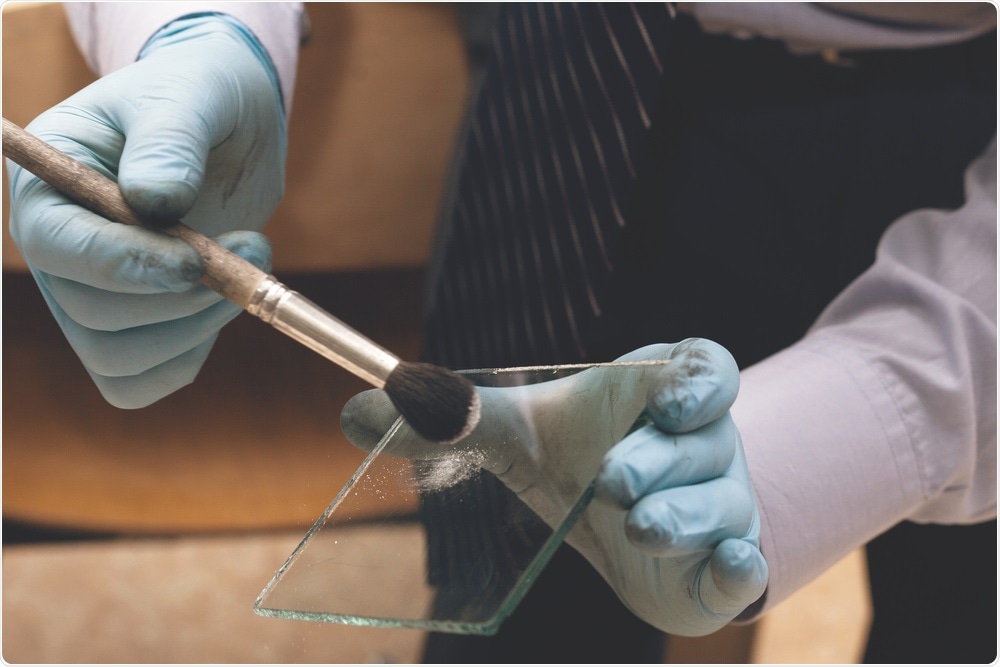Researchers at Iowa State University have established a way to determine the age of fingerprints that could enable forensic investigators to establish how much time has passed since they were left.

Image Credit: Franz12/Shutterstock.com
A team from the university’s chemistry department demonstrated that using matrix-assisted laser desorption/ionization - mass spectrometry imaging (MALDI-MSI) to analyze the presence of unsaturated triacylglycerols (TGs) within latent fingerprints accurately determined the time since deposition.
Fingerprint analysis as an established identification method
Analyzing the unique features found in a person’s fingerprints and using algorithms to match the features with database information is a reliable and widely used identification method in forensic cases. Variations in endogenous and exogenous compounds within fingerprints provide details about a person’s gender, ethnicity and even lifestyle.
Over the last ten years, researchers have focused on the chemical information within fingerprints because profiling based on chemical analysis would significantly improve their evidentiary value, especially in the absence of a database match.
The challenge
However, although forensics teams heavily rely on fingerprinting as an identification method and despite the endeavor to increase evidentiary value, there is still no reliable technique for determining the age of fingerprints.
Developing a reproducible fingerprint age determination method is crucial to reliably establish time since deposition in forensic cases…Establishing a latent fingerprint age would allow forensic personnel to determine if a latent fingerprint was relevant to a crime.”
Young-Jin Lee and colleagues
The team says various studies have attempted to interpret fingerprint aging, but they have not yet provided an answer. Researchers have used gas chromatography-MS (GC-MS) to investigate the aging of unsaturated lipids and have suggested factors such as oxidation and concealment in containers should be considered.
However, while these studies have pointed towards some chemical processes that occur as fingerprints age, they have still not led to a reliable fingerprint age determination model, which would be particularly important for the crucial first few days of aging. Furthermore, such studies use an extraction process that means the forensic evidence is not preserved.
One study that used liquid chromatography-MS (LC-MS) to study the effects of ozonolysis on TGs showed a decrease in TG abundance and an associated increase in ozonide over time. Analysis using MALDI-MSI did confirm the presence of ozonide in the fingerprints, but the samples used had already aged by 26 days.
What did the current study involve?
As reported in the journal Analytical Chemistry, Lee and colleagues have now used MALDI-MSI to determine whether the ambient degradation of TGs could be used to establish the age of fingerprints, especially within the first few days since deposition.
Three people deposited fingerprint samples on clean glass slides which were either immediately prepared and analyzed (fresh fingerprints) or stored under ambient conditions (aging fingerprints) for different periods in a windowless room that was fluorescently lit for around 8 hours each day.
MALDI-MS was used to measure the abundance of saturated and unsaturated TGs in the fresh fingerprint samples and at various time points over seven days for the aging samples. Samples were also dusted with a carbon forensic development powder that would eliminate the need for extraction and preserve forensic evidence.
What did the study find?
The team reports that unsaturated TGs underwent degradation due to ambient ozonolysis, which led to a decrease in their abundance over time. Two series of compounds that were related to this degradation emerged over time and could be detected within just one day of aging.
The degradation of unsaturated TGs was shown to be reproducible for each individual and the between-individual differences in degradation rate were attributed to differences in the abundance of unsaturated lipids, says the team.
The authors point out that the degradation rate was reproducible for each individual, even though certain variables such as humidity or ambient ozone level were not controlled for, indicating the reliability of the technique for determining a given individual’s fingerprint age.
Furthermore, “even after forensic development TGs and their ozonolysis products could be detected in latent fingerprints using MALDI-MSI, making this approach more compatible with current forensic practices and streamlining the process,” the authors write.
To check for the influence of the time lag between collection and analysis, the team aged fingerprints in sealed containers for three days and aged another fingerprint under ambient conditions.
The researchers observed no ozonolysis degradation in the sealed, contained fingerprints, while the fingerprint aged under ambient conditions did show the degradation.
“This indicates that fingerprints collected at a crime scene would not continue to degrade if properly stored,” writes the authors “Hence, the degree of aging could then be attributed to the amount of time since deposited at the crime scene and not influenced by the time lag between collection and analysis.”
What is next?
The team suggests that MALDI-MSI analysis of the unsaturated TG abundance over time could be used to establish latent fingerprint age.
The authors say they intend to study the effects that ozone level and other environmental factors have on the degradation rate, with a focus on the overall lipid content and the effect on degradation rate. Future studies will also include more participants to “refine to refine the conclusions presented in this work,” they add.
Journal reference:
Lee Y, et al. Determining Fingerprint Age with Mass Spectrometry Imaging via Ozonolysis of Triacylglycerols. Analytical Chemistry 2020. DOI: 10.1021/acs.analchem.9b04765